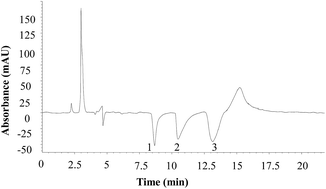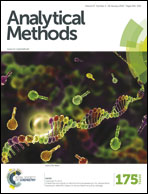Hydrophilic interaction liquid chromatography for separation and determination of pyrrolidinium ionic liquid cations
Abstract
A convenient and versatile method was developed for the separation and detection of pyrrolidinium ionic liquid cations by hydrophilic interaction liquid chromatography (HILIC) with indirect ultraviolet detection. Chromatographic separation was achieved on a hydrophilic column using background ultraviolet absorption reagents and organic solvents as the mobile phase. HILIC mechanisms were investigated by studying the effects of background ultraviolet absorption reagents, detection wavelength, organic solvents, and pH of the mobile phase on the separation and determination of pyrrolidinium cations. Good retention of very polar ionic liquid cations was obtained in HILIC. The optimized chromatographic conditions were selected by using 0.8 mmol L−1 4-aminophenol hydrochloride aqueous solution (pH 3.0)/acetonitrile (25/75, v/v) as the mobile phase and a detection wavelength of 230 nm. The method is simple and selective and is believed to be applicable for pyrrolidinium ionic liquids synthesized in the laboratory. This is an improved analytical method for ionic liquid cations. Compared to reversed phase liquid chromatography, the HILIC method provides an alternative approach for enhancement of retention of polar ionic liquid cations.


 Please wait while we load your content...
Please wait while we load your content...